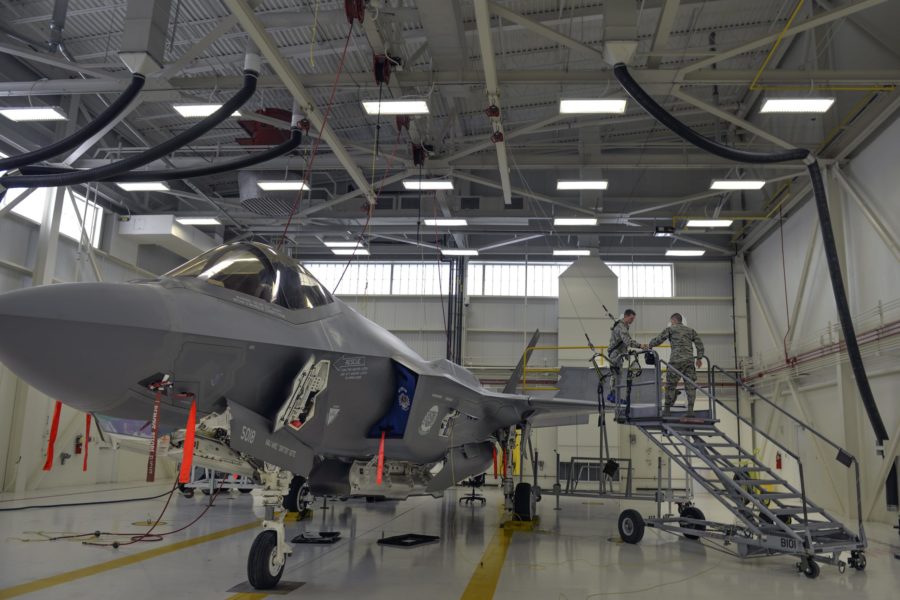The Pentagon will try again to negotiate a Performance-Based Logistics contract to support F-35 sustainment, but a shortage of available subject matter experts and a lack of substantial benefits in the deal offered by Lockheed Martin caused the government to suspend the talks, DOD acquisition and sustainment chief William LaPlante told a House Armed Services Committee panel on Dec. 12.
In a hearing focused on the F-35 program, lawmakers also questioned LaPlante and other experts about the status of the Tech Refresh 3 update and an alternative engine for the fighter.
“We’ve not made the decision to walk away from a Performance Based Logistics [contract] overall, at the system level,” LaPlante told the Tactical Air and Land forces subcommittee. “We had to pause just because of the manpower.”
With a limited number of experts having to shift to other duties, there weren’t enough people available to have a comprehensive conversation, LaPlante said, and the talks were tabled. Interim deals continuing with the existing support arrangement will be struck for March and likely June, he said.
Lockheed’s proposal also did not offer “sufficient cost savings, if any, and no performance savings,” he said. “So we put pause on the PBL to focus on extending the current contracting.”
If an overall deal can’t be struck, LaPlante said it might make sense to break the PBL into certain subsystems.
Right now, though, work needs to be done to define the right metrics for measuring success with a PBL, LaPlante said. The government wants to use one called Gross Issue Effectiveness Rate requirements, which LaPlante explained is a “percentage of total demands filled at the base with onsite inventory, divided by total number of demands, and supply response time. We think those are good metrics.”
Making it work will require reliable data, however.
“But we haven’t given up on it,” LaPlante said of a PBL. “We just were not … going to wrap up the negotiation on this one in the time we needed. And I wouldn’t have been able to satisfy the requirement to have it certified for the price savings.”
Pressed to explain why the Joint Program Office doesn’t have enough people to conduct the PBL negotiations in a timely manner, JPO director Lt. Gen. Michael J. Schmidt said there is a limited group of individuals who know the F-35’s systems well enough to do the work.
“These are huge contracts with quotes from all the suppliers that come in,” and the team was overwhelmed, he said.
“I had to either show Dr. LaPlante that I had a closure plan that would get us there—like, right now—or pivot to extending our current contracts. Otherwise, we’d be at risk of sustaining our fleet,” Schmidt said.
Schmidt said there is a “full handshake” deal on the first support contract extension to March.
“We are quickly closing on the extension to June,” he added, saying he hoped it would be completed within the next few weeks. After that, Schmidt and LaPlante will have to settle on a “broader acquisition strategy … [which] in my opinion, must be incentive-based in order to drive the proper industry behaviors and commitments going forward,” Schmidt said.
Upgrades
Schmidt also said the Tech Refresh 3 processor upgrade now in testing is not being produced “at a rate where it needs to be. It is not meeting our contractual requirements.”
The problem lies with the supply of some key components, he said, with the component shortage affecting the Distributed Aperture System, or DAS.
TR-3 “needs to come up the curve very quickly in order to meet our production,” Schmidt said, and the shortage may also affect retrofits of older aircraft down the road.
If TR-3 was fully ready, “there were 52 airplanes that … would have been delivered by the end of by the end of December,” Schmidt reported. Instead, only 21 have been delivered. “The rest of the airplanes are being held,” he said.
“We will catch up quickly” if supplies of the short components reach adequate levels, he added.
LaPlante acknowledged the scope and cost escalation of the Block 4 modification, which depends on the TR-3, has increased from 66 improvements at a cost of $10.6 billion, completed by 2026; to 80 improvements at a cost of $16.5 billion, to be delivered by 2029. This was due to changes in requirements, he said—the program initially expected the improvements would come in a rolling manner.
Jon Ludwigson of the Government Accountability Office reminded lawmakers that the GAO has suggested breaking out the Block 4 upgrade as its own Major Defense Program, so that the cost of its elements can be scrutinized with greater clarity. As part of the overall F-35 program, he said Block 4 schedule or cost problems look smaller and are harder to tease out from other issues.
Engine Work
LaPlante and Schmidt both said that as much as they would like to pursue a new engine competition for the F-35, costs and applicability to all F-35 types compelled them to select an F135 engine upgrade instead. LaPlante noted that the Adaptive Engine Transition Program (AETP) engines developed by Pratt & Whitney and GE Aerospace will only fit the F-35A used by the Air Force and possibly the F-35C used by the Navy, but not the F-35B, which uses a unique short takeoff/vertical landing mechanism.
Rep. Carlos A. Gimenez (R-Fla.), however, said performance should have been a greater consideration than “just a business case” decision to do the more modest upgrade.
“If I’m the fighter pilot, I want the engine that takes me faster and takes me longer,” he said. “This is a performance issue … for the life of our pilots and the capability of this airplane, especially in a theater which we may be finding ourselves in.” A future conflict “is going to need this enhanced capability,” he added.
LaPlante acknowledged the AETP program “did everything we asked it to” and provided upwards of 30 percent improvement in range and double-digit improvements in acceleration.
